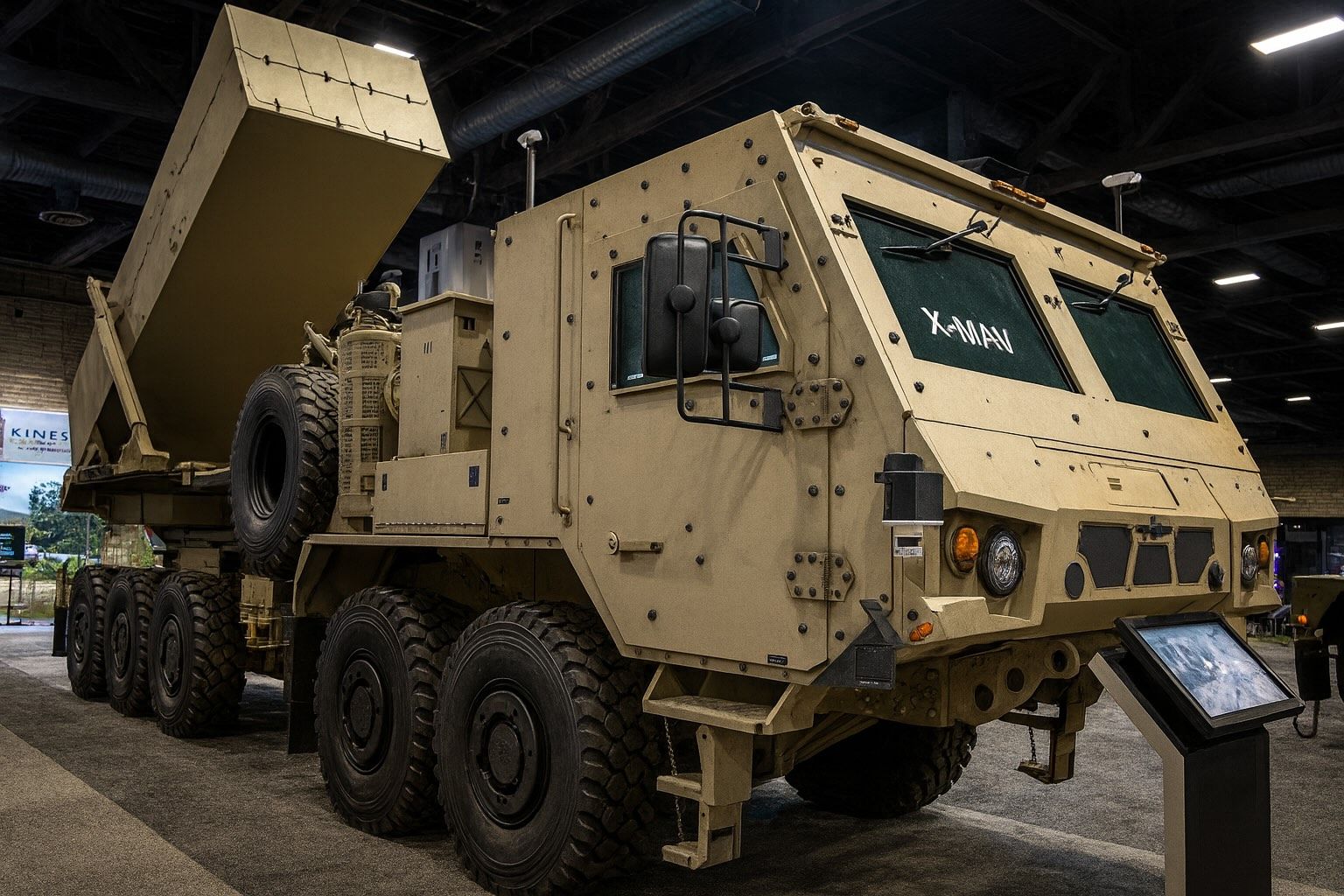- Oshkosh FMAV lineup: At AUSA 2025 (Oct 13–15, Washington D.C.), Oshkosh Defense unveiled its Family of Multi-Mission Autonomous Vehicles (FMAV) – a new line of optionally manned/autonomous combat vehicles built on proven U.S. tactical platforms [1] [2]. Oshkosh says the FMAV supports Army modernization priorities like long-range precision fires, resilient formations and scalable autonomy, offering “production-ready” solutions to reduce risk in contested environments [3] [4].
- X-MAV – Autonomous Tomahawk launcher: The Extreme Multi-Mission Autonomous Vehicle (X-MAV) is a heavy 8×8 UGV equipped as a Tomahawk missile launcher [5] [6]. Oshkosh displayed the X-MAV at AUSA carrying four Tomahawk Land Attack Missiles – the same four-missile loadout as the Army’s old Typhon ground-launcher system [7] [8]. Unlike trailer-based launchers, X-MAV is purpose-built for off-road mobility: it has a rugged chassis, onboard power and autonomy systems so it can drive, hide and “shoot-and-scoot” anywhere [9] [10].
- M-MAV – Autonomous MLRS launcher: The Medium Multi-Mission Autonomous Vehicle (M-MAV) is based on Oshkosh’s FMTV A2 medium truck and carries pods of MLRS rockets [11] [12]. It can fire the entire MLRS Family of Munitions – including guided GMLRS rockets, ATACMS/PrSM ballistic missiles and future rounds like the Joint Reduced Range Rocket (JR3) [13] [14]. According to Army Recognition, the M-MAV “reduces crew risk while expanding survivability and dispersed firepower,” thanks to its remote-control/autonomous navigation and automated reload capability [15].
- L-MAV – Light multi-role UGV: The Light Multi-Mission Autonomous Vehicle (L-MAV) is a small autonomous truck (derived from the USMC’s ROGUE-Fires platform) designed for last-mile tasks and anti-drone missions [16] [17]. Oshkosh showed L-MAV carrying four AeroVironment Switchblade 600 loitering drones and a BlueHalo Titan counter-UAS launcher [18] [19]. Its modular payload bay means L-MAV can be reconfigured quickly for logistics, electronic warfare or other roles, furthering the Army’s “crewed/uncrewed teaming” concept [20] [21].
- Autonomy & deployment: All FMAV variants are “payload-agnostic” and optionally manned [22] [23]. Oshkosh emphasizes that FMAV vehicles use battle-tested truck and armored-car chassis, with scalable autonomy overlays. Pat Williams, Oshkosh’s Chief Programs Officer, notes the Army needed platforms “ready now,” and Oshkosh designed FMAV “on proven tactical vehicles, with scalable autonomy and payload versatility to deliver what the Army needs today…as the battlefield evolves.” [24] In practice, each vehicle can drive under AI control or be piloted remotely, reducing soldier exposure and allowing widely dispersed “resilient fires” networks [25] [26].
- Context – long-range fires: The FMAV rollout dovetails with renewed U.S. focus on long-range strike. Naval News notes that Oshkosh’s new launchers support “long-range munitions” priorities like CAML-H (Common Autonomous Multi-Domain Launcher, heavy) – an Army program to field 15-ton autonomous launchers for Tomahawk missiles [27] [28]. By embedding sensors, power and autonomy on mobile trucks, Oshkosh aims to make ground-launched cruise missiles far more agile than past container systems. Army Recognition observes that the X-MAV “reframes land-based cruise missile employment as a question of mobility and survivability, not just range,” and could eventually supplement or replace static containers [29].
- Ukraine tie-in – ground-based Tomahawks: The Oshkosh news comes amid intense debate over providing Ukraine with U.S. Tomahawk missiles. Kyiv’s leaders have long requested the 1,600+ km-range cruise missile to hit Russian military targets. The problem – “how would Ukraine launch [sea-launched Tomahawks]?” – may be solved by a ground vehicle like the X-MAV [30]. As the Kyiv Independent reports, Oshkosh presented X-MAV at AUSA configured with four Tomahawks [31]. Analysts say giving Ukraine land-launchers would radically expand its deep-strike options, letting Kyiv target key bases, HQs or even Moscow and St. Petersburg from behind friendly lines [32] [33].
- Expert/leader views: U.S. and Ukrainian officials are already positioning for Tomahawks. On Oct. 12, U.S. President Donald Trump said he’s “prepared” to send Tomahawks to Ukraine, though he wants to discuss the plan with Russia first [34]. Ukrainian President Volodymyr Zelenskyy told Fox News the day before that any Tomahawks Ukraine receives “will be used only against Russian military targets,” emphasizing restraint [35]. As one analyst put it, long-range Tomahawks “would allow Ukraine to strike military targets deep inside Russia and increase pressure on Putin,” if approved [36]. All this makes a mobile launcher attractive: X-MAV could let Ukraine field missiles without relying on ships or bombers.
- Allied interest: Ground-launched Tomahawks interest more than just Ukraine. NATO partners have eye’d similar systems. For example, Germany’s Defense Minister Boris Pistorius recently confirmed Berlin is “studying the possibility of purchasing mobile Typhon launchers” from the U.S. (the Cold-War containerized system for Tomahawks) [37]. Like X-MAV, each Typhon launcher also carries four missiles (including Tomahawk or SM-6 anti-air missiles) in a truck-mounted canister [38]. The German government says any such purchase would be for deterrence. In short, Oshkosh’s reveal underscores a broader push: U.S. and allies want mobile, land-based Tomahawk launchers to deter aggression across Europe and Asia.
- Why it matters: For military analysts, the FMAV lineup signals a new phase in missile warfare. Unlike Cold War fixed launch sites, these vehicles can disperse, camouflage and shoot on the move – complicating an enemy’s targeting. Oshkosh’s X-MAV in particular “adds mobility and a smaller signature” to Tomahawk missiles [39], making them harder to find and destroy. Pat Williams calls FMAV “the ideal foundation” for future long-range weapons in “multi-domain missions” [40]. As one U.S. Army official noted in August, the Army’s CAML program envisions “an autonomous-capable, high-endurance launcher for long-range fires,” exactly what Oshkosh is now demonstrating [41] [42].
- Bottom line: The AUSA 2025 reveals show that battlefields are changing. Autonomous trucks like Oshkosh’s FMAV can extend the reach of artillery and rockets while protecting crews. They may also soon bring the Tomahawk cruise missile onto land – a capability that, if transferred to Ukraine or deployed to allies, could alter the strategic balance. As one analyst observed, the X-MAV and its siblings shift the focus from “containerized launchers to purpose-built platforms that can hide, fire and reposition quickly” [43] [44]. In short, Oshkosh’s new “war wagons” point to a future where long-range fire is faster, more flexible and more lethal than ever.
Sources: Official Oshkosh press materials and defense media reports [45] [46] [47] [48] [49] [50]. These include Oshkosh Defense announcements and coverage by Naval News, Army Recognition, Kyiv Independent, United24, DefenseMirror and Al Jazeera.
References
1. defensemirror.com, 2. oshkoshdefense.com, 3. defensemirror.com, 4. oshkoshdefense.com, 5. oshkoshdefense.com, 6. defensemirror.com, 7. www.navalnews.com, 8. mezha.media, 9. united24media.com, 10. mezha.media, 11. www.armyrecognition.com, 12. www.navalnews.com, 13. www.navalnews.com, 14. mezha.media, 15. www.armyrecognition.com, 16. defensemirror.com, 17. www.navalnews.com, 18. www.navalnews.com, 19. defensemirror.com, 20. www.armyrecognition.com, 21. defensemirror.com, 22. oshkoshdefense.com, 23. www.armyrecognition.com, 24. oshkoshdefense.com, 25. www.armyrecognition.com, 26. oshkoshdefense.com, 27. mezha.media, 28. www.army.mil, 29. www.armyrecognition.com, 30. kyivindependent.com, 31. kyivindependent.com, 32. kyivindependent.com, 33. www.aljazeera.com, 34. kyivindependent.com, 35. www.aljazeera.com, 36. kyivindependent.com, 37. mezha.media, 38. mezha.media, 39. united24media.com, 40. mezha.media, 41. www.army.mil, 42. breakingdefense.com, 43. www.navalnews.com, 44. www.armyrecognition.com, 45. oshkoshdefense.com, 46. www.navalnews.com, 47. kyivindependent.com, 48. united24media.com, 49. defensemirror.com, 50. www.aljazeera.com










